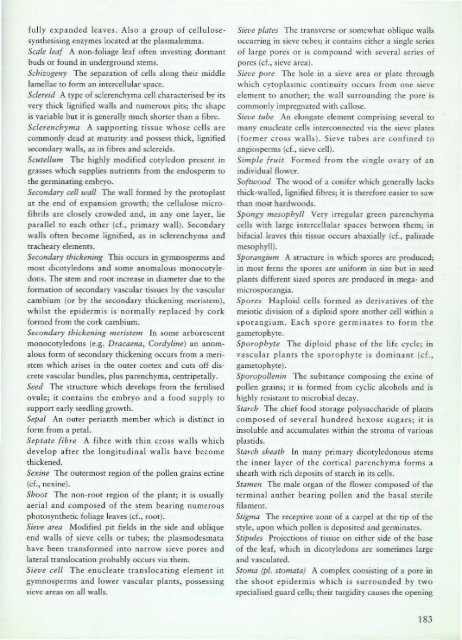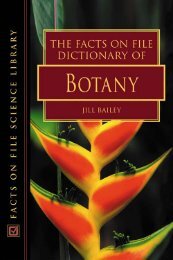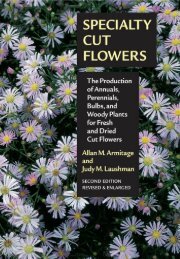You also want an ePaper? Increase the reach of your titles
YUMPU automatically turns print PDFs into web optimized ePapers that Google loves.
fully expanded leaves. Also a group of ccllulosesynthesising<br />
enzymes located ar the plasmalemma.<br />
Scale leaf A non-foliage leaf often investing dormant<br />
buds or found in underground stems.<br />
Schizogeny The separarion of cells along their middle<br />
lamellae to form an intercellular sp:lce.<br />
Sclereid A type of sclerenchyma cell characterised by its<br />
very thick lignified walls and numerous pits; the shape<br />
is variable but it is generally mueh shaner than a fibre.<br />
Scferenchyma A supporting tissue whose cells arc<br />
commonly dead at maturity and possess thick, lignified<br />
secondary walls, as in fibres and sclereids.<br />
Scutellum The highly modified cotyledon present in<br />
grasses which supplies nutrienrs from the endosperm to<br />
the germinating embryo.<br />
SecondiJry cell wall The wall formed by the protoplast<br />
at the end of expansion growth; the cellulose microfibrils<br />
are closely crowded and, in anyone layer, lie<br />
pacallel to each other (d., primary wall). Secondary<br />
walls often become lignified, as in sderenchyma and<br />
tracheary elements.<br />
Secorulary thickemng This occurs in gymnosperms and<br />
moSt dicotyledons and some anomalous monocotyledons.<br />
The stem and root increase in diameter due to the<br />
formation of sccond:lry vascular tissues by the vascular<br />
cambium (or by the secondary thickening meristem),<br />
whilst the epidermis is normally replaced by cork<br />
formed from the cork cambium.<br />
Secondary rhickening meristem In some arborescent<br />
monocotyledons (e.g. Dracoeno, Cordyfine) an anomalous<br />
form of secondary thickening occurs from a meristem<br />
which arises in the outer cortex and Cuts off discrete<br />
vascular bundles, plus parenchyma, centripeta11y.<br />
Seed The structure which develops from the fertilised<br />
ovule; it contains the embryo and a food supply to<br />
support early seedling growth.<br />
Sepal An outer perianth member which is distinct in<br />
form from a petal.<br />
Septate (ibre A fihre with thin cross walls which<br />
develop after the longitudinal walls have become<br />
thickened.<br />
Sexine The outermost region of the pollen grains eetine<br />
(d., nexine).<br />
Shoot The non-rOOt region of the plant; it is usually<br />
aerial and composed of the stem bearing numerous<br />
photosynthetic foliage leaves (d., root).<br />
Sielle area Modified pit fields in the side and oblique<br />
end walls of sieve cells or rubes; the plasmodesmata<br />
have been transformed into narrow sieve pores and<br />
lateral translocation probably occurs via them.<br />
Sieve cell The enucleate translocating element in<br />
gymnosperms and lower vascular plants, possessing<br />
sieve areas on all walls.<br />
Sielle plates The transverse or somewhat oblique walls<br />
occurring in sieve tubes; it conrains either a single series<br />
of large pores or is compound with several series of<br />
pores (ct., sieve area).<br />
Sil've pore The hole in a sieve are;! or plate through<br />
which cytoplasmic continuity occurs from one sieve<br />
clement to another; the wall surrounding the pore is<br />
commonly impregnated with callose.<br />
Sieve tube An elongate clement comprising several to<br />
many enucleate cdls interconnected via the sieve plates<br />
(former cross walls). Sieve tubes are confined to<br />
angiospenns (cL sieve cell).<br />
Simple (ruit Formed from the single ovary of an<br />
individual flower.<br />
Softwood The wood of a conifer which generally lacks<br />
thick-walled, lignified fibres; it is therefore easier to saw<br />
than most hardwoods.<br />
SpoJigy mesophyfl Very Irregular green parenchyma<br />
cells with large intercellular spaces bC'twttn them; in<br />
bilacial lea\'es this tissue occurs abaxiaUy (d., palisade<br />
mesophyll).<br />
Sporangium A .structure in which spores are produced;<br />
in most fems the spores are uniform in size but in seed<br />
plantS different sized spores are produced in mega- and<br />
. .<br />
mlerosporangl3.<br />
Sporl's Haploid cells formed as derivatives of lhe<br />
meiotic division of a diploid spore mother cell within a<br />
sporangium. Each spore germinates to fOlm the<br />
gametophyte.<br />
Sporophyte The diploid phase of the life cycle; in<br />
vascular plants the sporophpe is dominant (d.,<br />
gametophyte).<br />
Sporopo/lenin The substance composing the exine of<br />
pollen grains; it is formed from cyclic alcohols and is<br />
highly resistant to microbial decay.<br />
Starch The chief food storage polysaccharide of plants<br />
composed of several hundred hexose sugars; it is<br />
insoluble and accuillulates within rhe stroma of various<br />
plastids.<br />
Starch sheath In many primary dicotyledonous stems<br />
the inner layer of the conical parenchyma forms a<br />
sheath with rich deposits of Starch in itS cells.<br />
Stamelf The male organ of the flower composed of the<br />
terminal amher bearing pollen and the basal sterile<br />
filamenr.<br />
Stigma The receptive zone of a carpel at the tip of the<br />
style, upon which po11en is deposited and germinates.<br />
Stipllfes Projections of tissue on either side of the base<br />
of the leaf, which in dicotyledons :lre sometimes large<br />
and vasculated.<br />
Stoma (pI. stomata) A complex consisting of a pore in<br />
the shOal epidermis which is surrounded by two<br />
specialised guard cells; their turgidity causes the opening<br />
183





